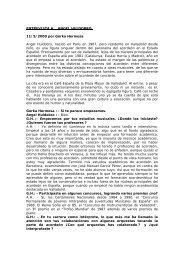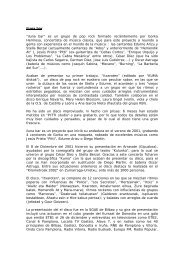The Accordion in the 19th Century - Gorka Hermosa
The Accordion in the 19th Century - Gorka Hermosa
The Accordion in the 19th Century - Gorka Hermosa
Create successful ePaper yourself
Turn your PDF publications into a flip-book with our unique Google optimized e-Paper software.
In 1898 he published an autobiography and <strong>in</strong> 1904 three compendiums of songs for <strong>the</strong><br />
accordion with figured notation. In 1897 <strong>the</strong> first gramophones arrived <strong>in</strong> Russia an<br />
soon afterwards, <strong>in</strong> 1901 he recorded his two first <strong>the</strong>mes for <strong>the</strong> company Gramophone<br />
Concert, s<strong>in</strong>g<strong>in</strong>g and play<strong>in</strong>g accompanied by a pianist. He became one of <strong>the</strong> bestknown<br />
artists <strong>in</strong> Sa<strong>in</strong>t Petersburg. He sold a great deal of records and recorded more<br />
than 20 <strong>the</strong>mes for different record companies until 1912, <strong>in</strong>clud<strong>in</strong>g one <strong>in</strong> Berl<strong>in</strong> <strong>in</strong><br />
1906 171 . He obta<strong>in</strong>ed a place <strong>in</strong> a symphonic orchestra 172 <strong>in</strong> 1909 <strong>in</strong> Kislovosko and <strong>in</strong><br />
1912 <strong>in</strong> Essentuk. [45, 94, 287]<br />
In <strong>the</strong> Saratov area, an unusual type of accordion is an <strong>in</strong>veterate tradition: <strong>the</strong><br />
Saratov harmonica, an accordion with bells, which sound after press<strong>in</strong>g <strong>the</strong> buttons on<br />
<strong>the</strong> left manual. <strong>The</strong> bells were first <strong>in</strong>troduced around 1856 (<strong>the</strong> first press reference to<br />
<strong>the</strong> bells dates from 1866). In late 19 th c., I.F. Orlansky-Titarenko started to excel and<br />
would become one of <strong>the</strong> most <strong>in</strong>fluential personalities <strong>in</strong> early 20 th c. concern<strong>in</strong>g <strong>the</strong><br />
Russian chromatic accordion. [287]<br />
Some of <strong>the</strong> most outstand<strong>in</strong>g accordionists <strong>in</strong> late 19 th c. were V.V. Andreev 173<br />
(who was a multi-<strong>in</strong>strumentalist for classical and popular music as well as composer of<br />
orig<strong>in</strong>al pieces for accordion and also <strong>the</strong> founder of <strong>the</strong> National Instrument Orchestra<br />
<strong>in</strong> Russia) and Peter Jukov (who improvised melodies and stood out for his remarkable<br />
spiritedness). In Moscow, Batichev and Kuznetsov became renowned; and <strong>in</strong> Tula,<br />
Nicolai I. Beloborodov (1828-1912) was <strong>the</strong> founder, <strong>in</strong> 1886, of <strong>the</strong> first known<br />
accordion orchestra (which even produced phonograph records s<strong>in</strong>ce 1908 and was<br />
active until 1914,<br />
tour<strong>in</strong>g <strong>the</strong> whole<br />
country) and his<br />
successor at <strong>the</strong><br />
orchestra V.P.<br />
Khegstrem.<br />
<strong>Accordion</strong><br />
orchestras became<br />
very fashionable<br />
musical features.<br />
Harmonia by Vasily<br />
Varshavsky (who<br />
recorded s<strong>in</strong>ce<br />
1903) was a<br />
remarkable example<br />
[35, 40, 226, 287, 395, 407, 417] Fig. 94: Beloborodov’s <strong>Accordion</strong> orchestra (1886) 174 .<br />
POLAND:<br />
<strong>The</strong> accordion spread very quickly <strong>in</strong> Poland to reach such popularity that a<br />
newspaper article published <strong>in</strong> Warsaw <strong>in</strong> 1863 regards <strong>the</strong> accordion as a “plague”<br />
because it was relegat<strong>in</strong>g o<strong>the</strong>r Polish traditional <strong>in</strong>struments to oblivion. [236]<br />
NORWAY:<br />
Around 1880 <strong>the</strong> first performers appear and became known play<strong>in</strong>g polkas,<br />
ma<strong>in</strong>ly: Gerhard Gulbrandsen (1858-1927), Peter Pedersen (1867-1948), Sever<strong>in</strong><br />
171 <strong>The</strong> record, entitled Moscow Hotchpotch, was released by Gramophone Company Ltd. and can be listened to at<br />
http://www.russian-records.com/details.php?image_id=4935&sessionid=f7f00eb2e62c7c31b9a8c0c0e627995c (321)<br />
172 At accordions.com [289] a symphonic orchestra is mentioned, but it means semi-professional folk <strong>in</strong>strumental ensemble.<br />
173 Also spelt Audreev. [287]<br />
174 Fig. taken from: Monichon [202] page 68.<br />
40




